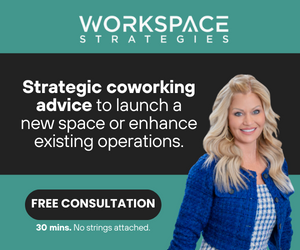- For workers around the world, returning to the office after working more than two years from home will feel a lot like the shift from high school to college.
- Now, workers hold more power over their own office experiences and schedules than they used to. Is the workplace ready to accommodate this new-found flexibility?
- Jamie Hodari, CEO of Industrious, explores what needs to change and why businesses should be intentional about in-person work.
By Jamie Hodari, CEO and co-founder of Industrious.
We all remember high school.
You walk into the building at a certain time every day, visit your locker, and go to your homeroom until the bell rings. From there, your schedule is set. One class follows another; a test here, a paper there, alternating throughout the day.
You rinse and repeat until the weekend arrives.
Then you graduate and go to college and you wonder if you’re not quite as ready as you thought you were to make your own decisions.
Expectations are set at multiple levels across a wide array of places — dorm rooms, coffee shops, libraries, student centers, seminar rooms, lecture halls — all serving different purposes for different groups at different times. Parents aren’t around to make sure you study and do homework. You have a schedule, but it’s a lot more discretionary.
Lectures where the professor doesn’t take attendance? Use that time to cram for finals. Office hours? Skip those — you’ve got papers to write. You get the point.
For workers around the world, preparing to return to the office after more than two years of WFH will feel a lot like the shift from high school to college.
The truth is, individual workers will hold more power over their own office experiences and schedules than they used to.
While employees are certainly looking for guidance from their employer, the post-COVID office requires businesses to act more like college advisors than home room teachers. Individual workers aren’t on their own, but they’re now in a position to control their own destiny (and schedules for that matter).
What does this mean for the physical workplace?
While there’s been no end to the thinkpieces, comment threads, TV interviews, and podcasts debating the once and future office, practical advice is in short supply.
That’s a problem as most businesses are realizing they have to do two things right off the bat:
1. Deliver a safe and productive employee experience
2. Provide the flexibility needed to change over time and adapt to new circumstances.
This requires that leaders consider and reevaluate the physical reality of the office.
Real estate is expensive. The unanswered question many business leaders continue to have is: do you downsize or do you change things around to create efficiencies?
The most important change will come from realizing what people actually want to do when they come in, and that reflects a clarifying insight of the last year.
People want to return to the office. Contrary to popular belief, this desire does not stem from them wanting to be more productive, but rather because they miss social interactions — that web of weak ties that makes up your life and accounts for the majority of your time.
If companies start there, the question becomes: how and where do you create more safe, collaborative spaces? Can desks and workstations be removed to favor meetings over heads-down work?
Employees will expect their days in the office to be time well-spent, and businesses should be more intentional about in-person work. With an emphasis on collaboration, changing the workplace becomes a matter of four deciding factors:
3. Distribute your workforce. Where do your employees do their best work? Allow them to decide if it’s from home, a satellite office, or headquarters they can commute to. Just as in college, some people will prefer to pull an all-nighter studying in their room, while others prefer a library desktop to write their papers. Getting the work done is what’s most important, not the where.
4. Manage variability and programming. More autonomy means more variability around who is in the office and who isn’t. Not dissimilar from the (sometimes dreaded) college group project: if you have to get together, make it worth everyone’s while. Focus on collaborative initiatives and creative brainstorms — and have a beer and snacks ready to go afterwards.
5. Decide what’s mandatory — and what isn’t. Companies need to be honest with themselves about what’s really necessary rather than optional. Maybe those all-staff meetings are a time suck that would be better spent on weekly huddles for collaborative work. Leaders should focus on making the most of the moments when the company gathers so that employees see in-person attendance as a value-add to their day.
6. Experiment and iterate. It’s not going to be perfect the first time through, but leadership should give it their best college try. Solicit regular feedback from your team because as circumstances change, what works one month might not the next, and you should reserve the right to be flexible.
Empowering leaders to set the norms
The reality is, everyone is figuring this out together right now. There is no universally-approved expertise that will set the course for all companies, sectors, or industries. Leaders and managers will need to set plans and be comfortable with the fact that those plans may change down the road.
But at the very least, the new normal demands more space dedicated to conference and meeting rooms, lounges, cafes, and huddle spaces — the room types that best promote collaboration, socializing, and team bonding.
Offices can serve as a cultural center for a business, and employees should return to work to find spaces that reflect that purpose.
Business leaders can send a powerful message that in-person collaboration is not only important, but also desirable and valuable both for employee morale and to a company’s bottom line.
It’s one of the silver linings to emerge from more than a year of remote work and distributed teams.
As employees prepare to graduate back to the office, business leaders have an opportunity to show they can teach lessons to a full house — even when attendance isn’t mandatory.
Written for Allwork.Space by Jamie Hodari, CEO and co-founder of Industrious.

 Dr. Gleb Tsipursky – The Office Whisperer
Dr. Gleb Tsipursky – The Office Whisperer Cat Johnson – Coworking Marketing Maven
Cat Johnson – Coworking Marketing Maven Angela Howard – Culture Expert
Angela Howard – Culture Expert Drew Jones – Design & Innovation
Drew Jones – Design & Innovation Andrea Pirrotti-Dranchak – Competitive Advantage
Andrea Pirrotti-Dranchak – Competitive Advantage Jonathan Price – CRE & Flex Expert
Jonathan Price – CRE & Flex Expert Jeremy Fennema – Tech Innovation Alchemist
Jeremy Fennema – Tech Innovation Alchemist







